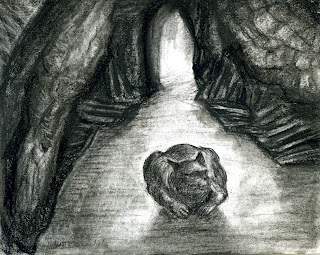When I was a drawing professor, I had my students experiment with unusual lighting conditions. The most commonly used lighting is what photographer’s used to call “butterfly” lighting, which is light from both sides of an object, and variations upon “hatchet lighting,” which is basically light from one side. I used these standard lighting upon objects but also used conditions of frontal lighting, back lighting and light from below.
What my students found from the three latter unusual lighting conditions is that they often imparted an unsettling or visually exciting atmosphere to the person or object. I called this effect part of the psychology of light in painting and drawing. I explained this to my students by way of equating light with power.
In art as in life, people find peace in relationships that approach a balance in power. If light represents power in a work of art, balance between art and viewer is best achieved when subject and viewer are in the same light. A light from the side does this. The light on the right side of a model’s face would be hitting the left side of a viewer’s face, hence all is opposite but equal with viewer and subject inhabiting the same world of balanced shadow and illumination.
So what would happen if the lighting, and hence the balance of power in a work of art and the viewer, tilts more heavily towards viewer or subject? Light coming on to a subject from below, especially onto to a face or figure, creates a ghoulish impression. The expected shadow beneath a nose is replaced by a lighted entrance to two caverns. Shaded eye sockets become illuminated, giving the subject a look of terror or surprise. Toulouse lautrec employed this kind of light for his actresses from the theater. Edvard Munch used light from below in his self portrait to evoke a state of angst - the power of light here emanating from an unknown source from the depths of the earth.
Light shining directly onto the surface of a subject is what I like to call the “deer in the headlights” look. This light effect is one that could be affected by shining a flashlight directly onto a subjects’ face. The balance of power shifts strongly from the subject to the viewer. Perhaps this is why interrogations were performed with light on a subject. In a work of art, frontal lighting makes a subject look frightened and vulnerable. The tendency of strong frontal light to flatten out facial features can be depersonalizing as well.
When light is emanating from behind, a subject is transformed into a looming dark silhouette, often with a thin halo of light around the edges. Two German Expressionist painters were found of using back lighting in their paintings and drawings; Max Beckman and Emil Nolde. In max Beckman’s full figure self portrait, now in the Busch Reisinger museum in Boston, he faces the viewer dressed in a black tuxedo and smoking a cigarette - striking an intimidating pose, his face and figure blackened by shadow. Nolde created a similar effect by drawing plants in front of brightly lit windows, making flowers look like flying canon balls of black. Back lighting creates a sense of mystery, awe, or fear. It is the opposite of the vulnerable deer in the headlights. It makes the viewer the vulnerable one caught in the spot light, unsettled and humbled.
For reasons that I cannot explain, I often use back lighting in my own drawings and paintings. People stand in front of windows with the backs turned to the viewer. Animals painted at dawn or dusk sport yellow or orange halos around their opaque bodies. To me this back lighting expresses the uncertain and unknowable, such as a face that cannot be read of an uncertainty as to the time of day.
In my last drawing using my old cat Max, I placed him in a cavern with the light coming from behind his form. The cavern was originally a badly drawn study of a hip bone that I cropped and turned upside down. The back lit cat has his ears turned backwards, the way cats turn to catch sounds from behind without obviously turning their heads or bodies. Someone would be calling the cat’s name perhaps. Or maybe he hears approaching footsteps. It will remain as mysterious as the source of light coming into his lair.
July 28, 2013
Subscribe to:
Post Comments (Atom)

No comments:
Post a Comment